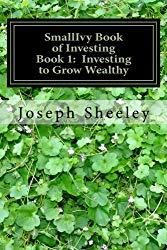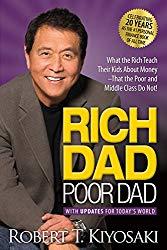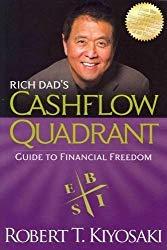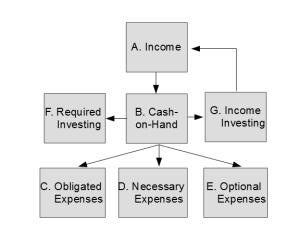About two years ago I started my second personal finance book. My first book, SmallIvy Book of Investing: Book 1: Investing to Become Wealthy, was about using investing to generate income and become financially independent, telling you what you need to do at each stage of your life to reach a point where you are sustained by your investments rather than your job. It provides a wealth of information on the different investment options (stocks, bonds, etc…) and some of the basics of investing for the novice investor. Importantly, it also provides information on the risks involved in different investments since that sort of information is not readily available in the books and the websites that you find. It then presents a strategy using individual stocks for long-term investing, along with the standard array of mutual funds as a base, in an effort to beat the markets and grow wealth. A good deal of that book is also spent in describing how to manage your finances to free up money for investing, as well as how to invest in your retirement accounts.

(Note, if you click on a link in this post and buy something from Amazon (even if you buy something different from where the link takes you), The Small Investor will receive a small commission from your purchase. This costs you nothing extra and is the way that we at The Small Investor are repaid for our hard work, bringing you this great content. It is a win-win for both of us since it keeps great advice coming to you (for free) and helps put food on the table for us. If you don’t want to buy something from Amazon or buy a book, how about at least telling your friends and family about our website as a great place to learn about investing and personal finance. Thanks!)
While I set out to write a book just about investing, with plans on writing a second book just on stock picking (that one is still in-the-works), I discovered that what was really needed was a book on what is called cash flow and how to control your cash flow to grow wealth. As described in Rich Dad Poor Dad: What the Rich Teach Their Kids About Money That the Poor and Middle Class Do Not!


By contrast, wealthy people take some of their income and invest it in assets – things that pay you money like stocks and rental real estate – and then feed that money back into their cash flow to augment their income. They then use some of the additional income to buy more assets, which creates even more income. Round and round you go, seeing your income increase until you reach financial independence because your assets pay for everything you need. My first book provided some of the how on buying assets and freeing up cash flow to buy investments. Robert Kiyosaki does a great job talking about buying assets, but obviously, people who have never invested really don’t know how to get started investing. The SmallIvy Guide to Investing was designed to provide that information, plus a lot more on personal finance.
For my second book, I decided to focus exclusively on cash flow since it is so important. I originally called the book Cash Flow Your Way to Wealth. It is centered around the creation of a cash flow diagram, which shows how money comes into your accounts and then flows out to various expenses and investments. Think of it like a budget on steroids, and actually creating a budget is the first step in creating one. It divides expenses up into different types of categories, things you must buy to live, things you are forced to buy because you’ve signed a contract, and things you choose to buy (luxuries). It then talks about how you can adjust how you spend money on these things to free up cash flow to go to investments and wealth generation. After you have created your first cash flow diagram based upon how you are making and using money now, it allows you to calculate your free cash flow and your free cash flow goal. If you are able to make your free cash flow equal your goal, which is based upon when you hope to retire and what income you’ll need in retirement, and then invest the money properly using the principles from The SmallIvy Guide to Investing, you now have a plan that will lead you to financial independence.

The Cash Flow DIagram
It also talks about how to direct money to required investments, which are things like retirement and college accounts, and how to invest for these purposes. Finally, and most importantly, it goes into income investments, which are the types of assets described in Rich Dad, Poor Dad, that add income so that you can grow your wealth more quickly than you can from your job and sustain it once you acquire it.
Having talked to some friends and coworkers who read beta copies of the book, I found that the title had something to be desired since many people do not know what cash flow is. Meanwhile, the FIRE movement had started in the personal finance world. FIRE, or Financially Independent, Retired Early is a movement sweeping the personal finance blogasphere. There are teachers on FIRE, Doctors on FIRE, Pharmacists on FIRE, and so on. The idea is to reach financial independence and retire in your forties or even thirties. I, therefore, decided to rename the book FIREd by Fifty: How to Create the Cash Flow You Need to Retire Early. I am hoping that people in the FIRE movement will be interested since cash flow really is the key to reaching financial independence. I choose “fifty” both for the alliteration and because someone in their twenties who picks up this book, creates a cash flow diagram, calculates their free cash flow goal and starts living by the principles should be able to reach financial independence in their late forties or perhaps early fifties.
Check out the neat FIRE pictures I was able to capture with a pie tin and some rubbing alcohol. I went with the third one for the cover photo for the book:




So, the book is going through the final edits and should be out next month. I am looking for some people to be reviewers once it is released so that I can get some reviews on Amazon. If you’re interested, I’m planning to provide autographed copies of both the new book and my first book to those who do. You’ll need to buy the first copy, either a paperback or a Kindle edition, since only those who purchase the book are able to write reviews, but I’ll send autographed hard copies to you once the review is posted. Please contact me if you are interested in being a reviewer.
Have a burning investing question you’d like answered? Please send to [email protected] or leave in a comment.
Follow on Twitter to get news about new articles. @SmallIvy_SI
Disclaimer: This blog is not meant to give financial planning or tax advice. It gives general information on investment strategy, picking stocks, and generally managing money to build wealth. It is not a solicitation to buy or sell stocks or any security. Financial planning advice should be sought from a certified financial planner, which the author is not. Tax advice should be sought from a CPA. All investments involve risk and the reader as urged to consider risks carefully and seek the advice of experts if needed before investing.
